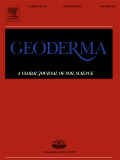
Geoderma
Scope & Guideline
Transforming Soil Studies for Tomorrow's Challenges
Introduction
Aims and Scopes
- Soil Carbon Dynamics:
Research on the processes and factors affecting soil organic carbon storage, transformation, and emissions, particularly in relation to land use, management practices, and climate change. - Soil-Plant Interactions:
Investigations into how soil properties and management practices influence plant growth, nutrient uptake, and overall ecosystem health. - Soil Fertility and Nutrient Management:
Studies that explore the dynamics of essential soil nutrients, the impact of fertilizers, and strategies for sustainable nutrient management in agricultural systems. - Soil Physics and Hydrology:
Research focusing on the physical properties of soils, including moisture retention, permeability, and their implications for water management and erosion. - Soil Remediation and Contamination:
Papers addressing the impact of contaminants on soil health, and the effectiveness of various remediation techniques to restore soil functionality. - Digital Soil Mapping and Modeling:
Advancements in methodologies for soil mapping using remote sensing, machine learning, and geostatistical approaches to improve soil resource management. - Soil Microbial Ecology:
Research on the composition, function, and interactions of microbial communities in soils and their contributions to nutrient cycling and soil health. - Soil Conservation and Land Management:
Studies focused on the effects of different land management practices on soil conservation, erosion control, and overall soil health.
Trending and Emerging
- Machine Learning and AI in Soil Science:
The application of machine learning and artificial intelligence techniques for predicting soil properties and mapping has gained significant traction, allowing for more accurate and efficient assessments. - Soil Health and Ecosystem Services:
Increasing emphasis on the role of soil health in supporting ecosystem services, including carbon sequestration, nutrient cycling, and biodiversity, highlighting the need for sustainable land management practices. - Impact of Climate Change on Soil:
Research examining the effects of climate change on soil processes, including carbon dynamics, nutrient cycling, and overall soil health, is becoming increasingly prominent. - Soil Microbial Functions and Diversity:
A growing focus on understanding the roles of soil microbial communities, their diversity, and their interactions with soil organic matter and nutrient cycling. - Soil Restoration and Rehabilitation:
Research directed towards strategies for restoring degraded soils, including the use of organic amendments and innovative management practices to improve soil quality. - Soil-Plant-Microbe Interactions:
Emerging studies that explore the complex interactions between soil, plants, and microbial communities are gaining importance, particularly in the context of sustainable agricultural practices. - Remote Sensing and Precision Agriculture:
The use of remote sensing technologies for soil assessment and management practices in precision agriculture is trending, emphasizing the integration of technology in soil science.
Declining or Waning
- Traditional Soil Classification Systems:
Research centered around traditional soil classification methods is becoming less prominent as there is a move towards more dynamic and integrative approaches that consider soil functions and ecosystem services. - Single-Factor Soil Studies:
Studies that focus solely on a single soil factor (e.g., pH or texture) without considering the broader context of soil interactions and ecosystem functions are decreasing. - Historical Soil Studies:
Research that primarily focuses on historical soil data without integrating modern techniques or perspectives on soil management is waning in favor of studies that emphasize current issues and sustainable practices. - Laboratory-Only Studies:
Research that relies solely on laboratory conditions is declining as the field increasingly values field-based studies that reflect real-world complexities and interactions. - Studies on Soil Erosion without Management Implications:
Research that examines soil erosion without recommendations for management practices or mitigation strategies is becoming less common as practical applications are prioritized.
Similar Journals

JOURNAL OF SOILS AND SEDIMENTS
Exploring the Foundations of Earth SciencesJOURNAL OF SOILS AND SEDIMENTS, published by SPRINGER HEIDELBERG, stands as a premier interdisciplinary platform dedicated to advancing the understanding of soil and sediment dynamics within the broader context of Earth sciences. With an impressive impact factor and a Q1 ranking in both Earth-Surface Processes and Stratigraphy, this journal not only reflects the high quality of research but also contributes significantly to the dialogue amongst researchers, professionals, and students in the field. The journal encompasses a wide spectrum of topics from sedimentology to soil science, making it essential reading for those involved in environmental management, agriculture, and geology. Access options are available to ensure that cutting-edge research is accessible to a global audience, reflecting the journal's commitment to fostering collaboration and innovation. As we converge towards 2024, JOURNAL OF SOILS AND SEDIMENTS aims to continue its role in shaping scientific inquiry and policy formulation concerning the vital roles of soils and sediments in ecological and geological systems.

Soil Science Annual
Bridging science and sustainability in soil studies.Soil Science Annual, published by Polskie Towarzystwo Gleboznawc, is an esteemed open-access journal dedicated to advancing the field of soil science and related disciplines. With its ISSN 2300-4967 and E-ISSN 2300-4975, this journal has been pivotal since its inception in 2012, providing a vital platform for researchers, professionals, and students to share innovative findings and insights. The 2023 Scopus rankings place the journal in Q2 for Earth and Planetary Sciences (miscellaneous), and Q3 for both Environmental Science (miscellaneous) and Soil Science, underscoring its influence and contribution to these fields. Housed in Warsaw, Poland, the journal fosters scholarly dialogue and dissemination of research findings critical to understanding soil mechanics, conservation practices, and sustainable land use. With its open-access model, Soil Science Annual ensures that research is accessible to a broad audience, encouraging collaboration and innovation in tackling global environmental challenges.
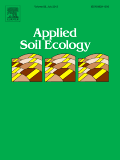
APPLIED SOIL ECOLOGY
Uncovering the Secrets Beneath Our FeetApplied Soil Ecology, published by Elsevier, is a premier journal dedicated to advancing the field of soil ecology through rigorous research and innovative methodologies. With an impressive impact factor and a consistent placement in the Q1 quartile across various categories including Agricultural and Biological Sciences, Ecology, and Soil Science, this journal underscores its significance in the scientific community. The journal's scope encompasses critical areas such as soil biology, microbial ecology, and the role of soils in ecosystem services, aiming to foster collaboration and knowledge exchange among researchers, professionals, and students. The convergence of research efforts from 1994 to 2024 highlights its commitment to maintaining current and relevant discourse within the field. While open access options are not available, the quality and depth of the articles published ensure that the latest findings and discussions are accessible through institutional subscriptions. With a strong focus on empirical studies and applied research, Applied Soil Ecology is an essential resource for anyone interested in the complexities of soil ecosystems and their impact on the environment.

EUROPEAN JOURNAL OF SOIL SCIENCE
Pioneering Research in Soil Ecology and ManagementEUROPEAN JOURNAL OF SOIL SCIENCE, published by Wiley, stands as a leading platform in the field of soil science, recognized for its contributions to the understanding of soil ecology, management, and sustainability. With an impressive impact factor and a distinguished Q1 ranking in Soil Science, this journal has recently ranked 23rd out of 159 in its category on Scopus, placing it in the 85th percentile among its peers. Covering a wide array of topics as it converges into the future, from 1994 to 2024, the journal aims to disseminate groundbreaking research and innovative methodologies that address the pressing challenges of soil degradation and environmental sustainability in Europe and beyond. Although it is not an open access journal, the EUROPEAN JOURNAL OF SOIL SCIENCE remains a vital resource for researchers, professionals, and students seeking to deepen their understanding and explore the latest advancements in soil science.
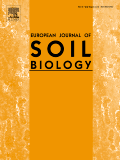
EUROPEAN JOURNAL OF SOIL BIOLOGY
Connecting Science and Soil for a Sustainable FutureThe EUROPEAN JOURNAL OF SOIL BIOLOGY is a leading publication through ELSEVIER FRANCE-EDITIONS SCIENTIFIQUES MEDICALES ELSEVIER, renowned for its rigorous contribution to the fields of soil science, microbiology, and insect science. Established in 1993 and continuing to thrive until 2024, this journal is recognized for its high academic standards, achieving a prestigious Q1 ranking across multiple disciplines including Insect Science, Microbiology, and Soil Science in 2023. With a Scopus rank placing it in the top tiers of relevant categories, the journal serves as a vital platform for disseminating groundbreaking research and advancements in soil biology. Although currently not an open access journal, it offers valuable insights to researchers, professionals, and students, enhancing understanding and fostering innovative solutions for global soil health challenges. The journal's ISSN is 1164-5563 and its E-ISSN is 1778-3615, offering a wealth of knowledge from an esteemed publisher situated in France.

EURASIAN SOIL SCIENCE
Connecting global experts in soil science research.EURASIAN SOIL SCIENCE, published by PLEIADES PUBLISHING INC, is a premier journal dedicated to advancing knowledge in the fields of soil science and earth-surface processes. With an ISSN of 1064-2293 and an E-ISSN of 1556-195X, this journal has been a key resource for researchers and professionals from its inception in 1992 and continues to thrive as it converges toward 2024. Situated in the United States, EURASIAN SOIL SCIENCE has achieved notable recognition, attaining a Q2 ranking in both Earth-Surface Processes and Soil Science categories as of 2023. Its Scopus rankings further underscore its importance, with Earth and Planetary Sciences placing it at #81/179 and Agricultural and Biological Sciences ranking it at #80/159. Engaging a global audience, this journal publishes cutting-edge research articles, reviews, and case studies that address critical issues related to soil health, conservation, and management. Though currently not open access, the journal offers valuable insights and fosters collaboration among scientists and practitioners, underscoring its vital role in enhancing the understanding of soil dynamics and sustainability.
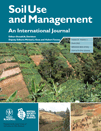
SOIL USE AND MANAGEMENT
Connecting research to practice in soil management.SOIL USE AND MANAGEMENT is a premier academic journal published by Wiley, focusing on the critical domains of Agronomy, Crop Science, Pollution, and Soil Science. With an ISSN of 0266-0032 and an E-ISSN of 1475-2743, the journal has established itself as a vital resource in the field since its inception in 1985. Operating from its U.S. headquarters in Hoboken, NJ, SOIL USE AND MANAGEMENT boasts impressive Q1 rankings across its relevant categories, indicating its standing in the top tier of research journals. Notably, it is ranked 48th out of 406 journals in Agronomy and Crop Science and holds an 88th percentile position, as well as a commendable rank of 26th out of 159 journals in Soil Science, underscoring its influence and reach. This journal serves as an essential platform for researchers, professionals, and students dedicated to sustainable soil management practices and understanding soil's role in agricultural productivity and environmental health. Although it does not offer Open Access, its rigorous peer-review process ensures the publication of high-quality original research, reviews, and case studies critical for advancing knowledge and practice in the field. This journal is crucial for anyone engaged in soil science and its related disciplines, encouraging innovative approaches to challenges facing soil use and management today.

Spanish Journal of Soil Science
Pioneering Access to Soil Science InsightsThe Spanish Journal of Soil Science is a prestigious open-access journal published by FRONTIERS MEDIA SA since 2011. Based in Switzerland, this journal serves as a vital platform for disseminating innovative research and applications within the field of soil science. With its commitment to accessibility, the journal enables researchers, professionals, and students from around the globe to contribute to and benefit from its wealth of knowledge. As of 2023, it holds a respectable Q3 category ranking in soil science and is positioned at #88 out of 159 in the Scopus rankings for Agricultural and Biological Sciences. The journal aspires to foster collaboration and communication among soil scientists, encouraging the exploration of contemporary soil issues, sustainable practices, and advancements in technology. Its open-access model ensures that the latest findings are freely available, promoting a broader impact in environmental and ecological studies.
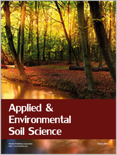
Applied and Environmental Soil Science
Empowering researchers to tackle pressing environmental challenges.Applied and Environmental Soil Science, an esteemed journal published by HINDAWI LTD, focuses on disseminating high-quality research in the fields of soil science and environmental applications. With an ISSN of 1687-7667 and an E-ISSN of 1687-7675, this open-access journal has been a vital resource for the academic community since its inception in 2009. As of 2023, it holds a commendable position in the Q2 category for both Earth-Surface Processes and Soil Science, highlighting its impact in these crucial disciplines. The journal’s rankings further affirm its significance within the field, being placed 61st in Earth and Planetary Sciences and 58th in Agricultural and Biological Sciences. Researchers and practitioners alike benefit from the collaborative platform it offers for sharing innovative studies essential for sustainable soil management and environmental integrity. With a focus on advancing knowledge and fostering interdisciplinary dialogue, Applied and Environmental Soil Science stands as a crucial pillar for scholars and professionals dedicated to addressing the pressing challenges of soil and environmental health.
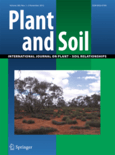
PLANT AND SOIL
Innovating research to enhance crop productivity and ecosystem balance.PLANT AND SOIL is a prestigious academic journal that has been at the forefront of plant and soil research since its inception in 1948. Published by SPRINGER in the Netherlands, this journal has carved a niche as a leading source of high-quality, peer-reviewed articles, which are essential for researchers, professionals, and students in the fields of Plant Science and Soil Science. With an impressive impact factor placing it in the Q1 category of both disciplines, it ranks 50th in the field of Plant Science and 24th in Soil Science, highlighting its influence in the scientific community. Although not available as open access, the journal provides a wealth of knowledge and insights into the interactions between plants and soils, exploring critical topics such as soil health, crop productivity, and sustainable agriculture practices. Researchers who wish to contribute to this vital area of study through their empirical findings will find PLANT AND SOIL to be an invaluable platform for disseminating their work and connecting with a network of leading scholars committed to advancing our understanding of these essential ecosystems.